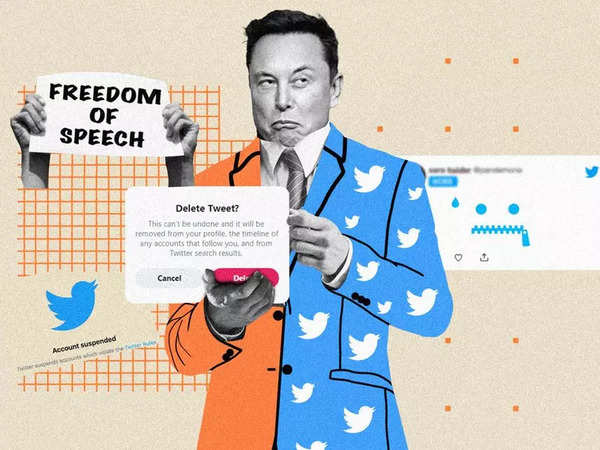An Inquiry into the business of news sharing & platform governance.
What happens when public platform turned private?

This is exactly what went down when Elon Musk acquired Twitter (now known as ‘X’) in a $44 billion deal last October (Conger, 2023). To turn it into an all-in-one app, and simultaneously become a site for audio, messaging, payment, and banking. As followed, a string of changes was made in action.
Whether if Elon’s vision a mere ambition or a reality? To answer, this article seeks to trace back the timeline of changes in analysis of the changes made to the present. In consideration of the social, economic, and political implications of each of the changes.
Included but not limited to the following actions:
- 50% job cut from acquisition
- Appearance changes (metrics, newsfeed display, content moderation)
- Premium model ($8 blue check subscription, $1 membership fees)
- Platform renamed (Twitter now ‘X’)
With community feedback, and academic theories combined to debunk the ‘free speech’ debacle. Where businesses are met by the resistance of social and political actors (Dutton, 2019).
Running a platform after all is not so simple.
50% Job Cut from Acquisition
Straight off Acquisition Musk jumped into action to reduce economic cost to what was coined an effort to maximise economic of scale. Highlighting the nature of flexibility in platform moderation, at the cost of instability within the occupation (Roberts, 2019). Quoting from an interview on the laid-off of 3,750 employees through email, Musk commented that a ‘lot of people doing things that didn’t seem to have a lot of value’(Dean, 2023). At the time this number was roughly half of Twitter’s workforce pre-acquisition. With another round of cuts thereafter, as reported ‘X’ is now down to 1,500 staff in May 2023 (Dean, 2023). Among the cuts were Twitter’s former top executives, product managers, data scientists and engineers.
Amid the backdrop of financial uncertainty, and historical loss-making. Such a drastic cut seems reasonably executed to reduce cost. However, the result of mass redundancy is offset by a drastic increase in misinformation and fake news. Often the labour of platform maintenance is misunderstood as lightwork mechanics. Re-enacting trade-off between freedom of speech and control (Dutton, 2019). Emphasising the necessity of labour remains essential in overlooking platform discourse. Insofar the manual invisible labour as the gatekeeper, highlighted over the floodgate of disinformation and controversies surfaced since the cutback of staff. Comparatively to the performance of Twitter over 7,500 pre-acquisitions are evidently much acquainted with the governance of the platform (Alba & Wagner, 2023). Whereas under Musk’s directions, the trade-off was made clear over the trade of moderation, and perhaps it was to enact his word ‘Free speech’.
Appearance changes
Among other things, Musk has made a few alterations to include new metrics of post view count, and function booked mark to save tweets. In addition to newsfeed was rearrangement into two sections ‘following’ and ‘for your page’ to follow the success of TikTok layout. Perceptively these were implemented to accelerate engagement and content discovery (Massanari, 2017). But to long-term users, this feedback was received with confusion and frustration over content far-reaching existing public interests. On the matter, longer-term usage may see users adjust to this new layout.
In the short term, the primary issue facing ‘X’ where not the cosmetic changes, but the misleading, offensive posts, and hate speech that flooded the openness of the platform (O’Hara & Hall, 2018). With the scale-down of content moderation tools limited to a handful of staff only, dropped to 15 (Guardian, 2022). Consequently, manual actions and account banning over misinformation were put on a break. Replaced by the formation of a ‘content moderation council’ to bring a ‘diverse view’. As put by Musk ‘the bird is freed’.

Effectively boycotting free speech has resulted in a surge in conservative and extremist content. With ‘X’ omission on governance, ultimately attracted fines from government regulators. Regulatory inadequacy contributed to the $385,000 fine by the Australian eSafety Commission, for failing to tackle proliferation of child pornography, and exploitation (Mcguirk, 2023). Ultimately the bluebird not so ‘freed’, must still conform to the capability of the internet to existing rules and authorities (Mueller, 2017).
Premium Model
Measures to implement of premium model highlight the nature of a privatised platform to prioritise economic gain over congregation over public value in constructing platform policies (Mansell & Steinmueller, 2020). Evidently with the introduction of premium subscription by $8 verification processes. Revamp at the removal of old check marks given to recognised identities such as celebrities, politicians, and public figures. Now paid service under colour-coded checks for corporate, government, and individuals. Most recently with format expanded to roll out of $1 annual fee trialled in NZ and the Philippines (Conger, 2023). Highlighting prioritisation of platform in-house revenue. To the business restructuring from, ads services to subscription revenue. Whereas the public value is positioned secondary to the platform. Followingly the current mechanism and negative social impact received, evidently neglection of social aspect over economic gain could be detrimental. Even long-established platforms such as Twitter, will bear opportunities for competitors to subsequently gain market power. In this instance, Meta has taken the market gap to launch its own text-based platform, Thread. X being the pioneer in text-based communication, may no longer stay on its crown amid debate. And drastic changes to the platform structure. In reconciling with the contingency of user participation, and market options as predicted. Even more, to question whether it’s too much and too soon.
Renaming to X
Formerly known for its iconic blue bird, and the creation of cultural value, to the invention of the terms such as ‘tweet’ and ‘retweet’. In replacement of the symbol X, further fuels the uncertainties of Twitter under Musk’s regime. Once again notions of cultural and social value are overlooked, to the loss of brand value and cultural association (Massanari, 2017). Further with the inconsistency of display on the webpage, X is named on the webpage but with the display of the bluebird. It resonated with Musk as a step forward to changing X into a one-for-all platform. Adversely practice highlights when policy decision-making is central to private individuals. It may not align with the public interest, much shown by the frustration of both users and advertisers. With Twitter losing out a quarter of its advertising revenue to the unfamiliar of ‘X’ (Counts et.al, 2023). Alternatively, the resistance of the public can be seen across, in the embedded cultural terms. To reference of ‘Tweets’ and ‘Twitter’ remain persist in media broadcasting and day-to-day discourse. Expansion of other actors in shaping policies, to the adaptation of active users in influencing platform policies. And once again reaffirms notions of successful platforms that must engage with multiple actors in activities of shaping platform policies and governance.
Concluding Marks
As of current, the operation of X under Musk’s directions remains vested with uncertainties. Among dive ‘freedom of speech’ that seems to depart from its intention to a heightened malicious activity. Much of this action was made in 12 months to restructure the platform. The future of Twitter remains unknown and is to be seen in practice. But for one that is certain. The identification of the platform is now much tied to the presence of Elon Musk. Platform governance and policies are no easy feat, successful players must frequently contend with multi-actors for the discourse of platform governance (Gowra, 2019).
References:
Alba,D., Wagner, K. (January 8, 2023)..Twitter Cuts more staff overseeing global content moderation. Bloomberg. https://www.bloomberg.com/news/articles/2023-01-07/elon-musk-cuts-more-twitter-staff-overseeing-content-moderation#xj4y7vzkg
Conger, K. (April 10, 2023). How Elon Musk Is Changing the Twitter Experience. The New York Times
Counts, A., Levine, J., BLOOMBERG. (July 24, 2023). By Turning Twitter into X, Elon Musk Risks Killing Billions in Brand Value. TIME.
Dean, G. (May 24, 2023). Elon Musk says that prior to its mass layoffs, Twitter had a ‘lot of people doing things that didn’t seems to have a lot of value’. INSIDER
Dutton, W. H. (2009). The Fifth Estate Emerging through the Network of Networks. Prometheus, 27(1), 1–15. https://doi.org/10.1080/08109020802657453
Gorwa, R. (2019). The platform governance triangle: Conceptualising the informal regulation of online content. Internet Policy Review, 8(2). https://doi.org/10.14763/2019.2.1407
Guardian Staff and agencies. (October 29, 2022). Elon Musk declares Twitter ‘moderation council’ – as some push the platform’s limits. The Guardian.
Mansell, R., Steinmueller, W. E. (2020). Economic Analysis of Platforms. In Mansell & W. E. Steinmueller, Advanced Introduction to Platform Economics (pp. 35–54).
Massanari, A. (2017). Gamergate and The Fappening: How Reddit’s algorithm, governance, and culture support toxic technocultures. New Media & Society, 19(3), 329–346. https://doi.org/10.1177/1461444815608807
Mcguirk, R. (October 16, 2023). Australian Safety watchdog fines social platform X $385,000 for not tackling child abuse content. ABC News
Mueller, M. (2017). Confronting Alignment. In Mueller, Will the Internet fragment? : sovereignty, globalization and cyberspace (pp. 50–56). Polity Press.
O’Hara, K., Hall, W. (2018). Four Internets: The Geopolitics of Digital Governance (No. 206). Centre for International Governance Innovation. https://www.cigionline.org/publications/four-internets-geopolitics-digital-governance
Roberts, S. T. (2019). Understanding Commercial Content Moderation. In Roberts, Behind the Screen: Content Moderation in the Shadows of Social Media (pp. 33–72). Yale University Press,. https://doi.org/10.12987/9780300245318



